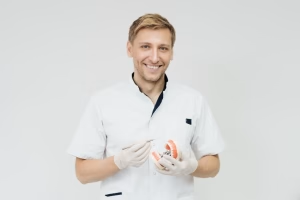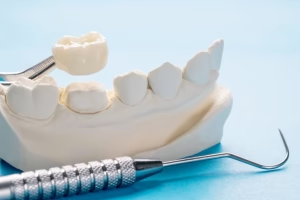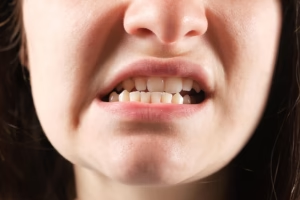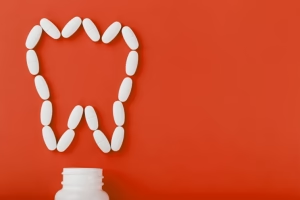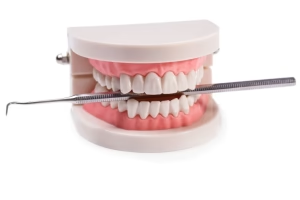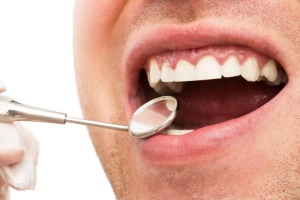What types of teeth exist?
21 November 2019 | Updated: 3 October 2025

Although many people don’t put that much thought into their teeth on a day to day basis, our teeth are vital to our health and well-being.
Our teeth are made of proteins and minerals—like collagen and calcium—and are one of the strongest, most durable parts of our bodies. And they’re tough for a reason! They act as our natural knives, grinding up our food so it’s easier to digest. But that’s not their only function. You might not have known this, but the teeth in our mouths help us enunciate our words clearly, allowing us to make hard sharp sounds. Our teeth are an important part of our well-being.
Our teeth come in 4 different types, each type a different shape, making them ideal for different functions but when they all work together they make the perfect grinding machine for our food.
Incisors are more often than not the first adult teeth to grow once our primary teeth, or baby teeth, fall out. They make up the front of our smile on both the top and bottom of our jaws. These are ordinarily the first teeth to grow, coming in once a baby is about 6 months old. The adult set of incisors usually grows by the time a child is 8 years old.
Cuspids, also known as canines, are the sharpest teeth in the human mouth. They might remind you of the teeth from the mouth of a carnivorous predator, or those long and sharp teeth vampires have from movies and stories. Baby canines grow between the ages of 16 months and 20 months, the upper ones growing in first, closely followed by the lower ones. Adult canines come in the opposite way around, with the lower ones emerging first around the age of 9 and the upper ones around the age of 11 or 12.
Molars are the so-called “backbone” of our teeth, being some of the largest and strongest teeth. They’re situated at the back of the jaw. Some molars come in around the age of 6, while others come in a little later around the age of 12. Wisdom teeth are also counted as molars, and are often called “third molars.” Wisdom teeth come in a lot later than the others, generally between the ages of 17 and 25. Many people experience pain when wisdom teeth start to emerge, but this often subsides once the teeth have fully settled in. Some people, however, opt for removing their wisdom teeth as they can tend to be problematic.
Premolars, or bicuspids, are very similar to molars. They sit a little further forward along the jaw and tend to grow a little later than the other teeth, generally around the age of twelve or thirteen.
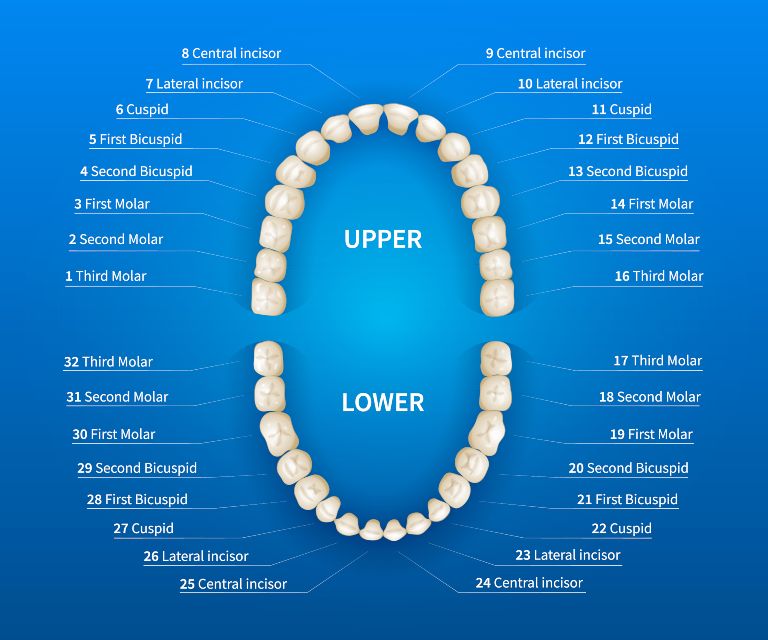
How Many Teeth Do Humans Have?
Teeth can be divided into two groups: adult teeth (or secondary teeth) and milk teeth (or primary teeth).
Babies start out with no teeth, and slowly but surely the milk teeth start to grow in. The first teeth to come in are generally the lower incisors which emerge once babies are 6 months old. Most children will have all 20 of their primary teeth by the age of 3:
- 4 incisors
- 2 canines
- 4 molars
Then kids will lose their primary teeth between the ages of 6 and 12, making way for the adult teeth to grow in. The wisdom teeth, or third molars, are the last to come in, but generally, most adults will have all their 32 secondary teeth fully grown in by the age of 21:
- 8 incisors
- 4 canines, or cuspids
- 8 premolars, or bicuspids
- 12 molars, including 4 wisdom teeth
Types of Function
Our teeth consist of 4 layers that come together to make one of the strongest components in the human body. These layers are enamel, dentin, pulp, and cementum.
The enamel makes up the outside layer of a tooth and is the hardest substance in our bodies.
Dentin is a little softer than enamel and makes up the second layer of a tooth.
The deepest layer of the tooth is called pulp and is made up of blood vessels and nerves. This part of the tooth is very soft and sensitive. And finally, cementum is the root of the tooth which is situated between the gums, giving the tooth a solid foundation.
Each type of tooth is shaped differently, making each of the teeth ideals for a specific type of function.
The teeth at the front of our mouths are called incisors and they’re thin and sharp, making them ideal for initially cutting food for that first bite.
They also make up the front of our smiles, which is why it’s important to keep these teeth looking good and whole.
Our four canines are the sharpest teeth we have, and their primary function is to tear food up.
Some people canines are actually too sharp and need to be filed down to avoid injury.
Our premolars only come in once our adult teeth start coming in and are not present at all in children.
These teeth function primarily as food crushers.
Our molars are the strongest teeth in our mouths, being the stoutest and flattest teeth in our mouths.
We use our molars to grind food down, making it easier to swallow and digest.
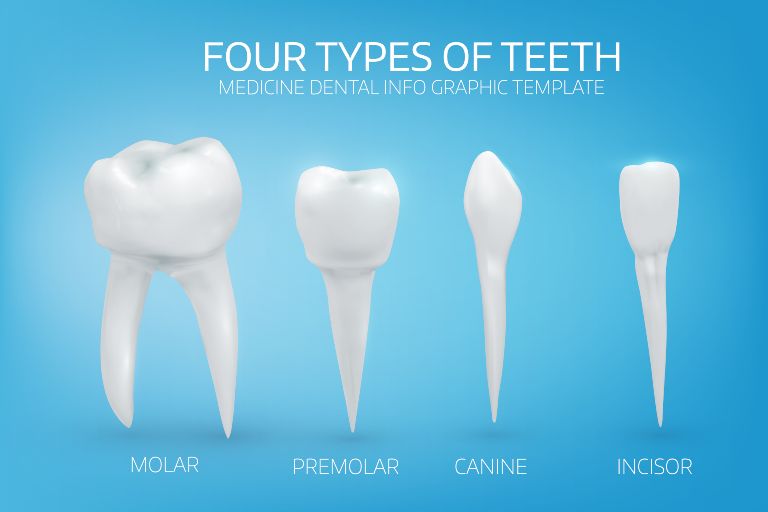
Treat Them Well
Our teeth are a great asset to our bodies, not just for aesthetic beauty and asymmetrical smile, but also for functionality in eating and digesting food properly.
Taking care of our teeth is a daily battle that we must keep up with in order to ensure the safety and well-being of our oral health. Looking out for your teeth will help you avoid cavities, bad breath, and stained or discolored teeth.
Tooth discoloration comes in two forms; extrinsic and intrinsic.
Extrinsic teeth stains occur on the surface of your teeth and is the result of pigmented residue from food and drinks building up in the protein that covers the enamel of our teeth. This can happen from regular smoking, using tobacco products, drinking wine, coffee, tea, or sugary drinks.
Intrinsic teeth stains occur below the surface of the tooth and happen when particles that cause staining make their way into the tooth’s enamel and accumulate. Using fluoride excessively has been associated with intrinsic teeth stains, particularly in children.
There are a few basic things we can do to try and keep our teeth healthy and clean. The first and most important one of these things is brushing our teeth. Make sure you brush your teeth twice a day, once in the morning and once in the evening. This is one of the surest ways to keep your teeth clean.
Teeth brushing is closely followed by flossing. Flossing is also incredibly important, since it’s not really possible to get rid of all the food residue that gets stuck between and underneath our teeth after eating. Flossing once a day should be sufficient to keep your teeth free of food particles that would otherwise start to rot and give you bad breath, as well as heighten the risk of cavities.
Watching what you eat and put in your mouth is also very important. Smoking wears down the enamel on our teeth and is definitely a leading cause of discolored teeth. Drinking too much coffee, caffeinated tea, or soft drinks will also damage our teeth. Eating candies or a lot of food that’s high in sugar content is also dangerous for our teeth and should be minimized. And try not to bite down on very hard or cold surfaces, like ice for example.
Keep your smile healthy with regular check-ups and professional cleaning. Whether you need routine dental care, deep cleaning, or expert advice, MGA Dental is here to help.




